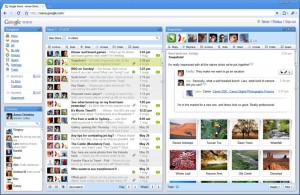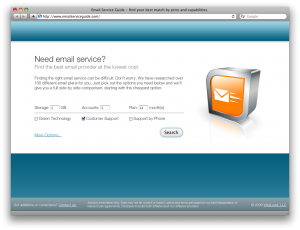This is the second article in a series about email by our guest writer Lore Dionne Candelaria.
After looking back on the humble beginnings of the communication medium that changed the way we see the world today in the article ‘45 Years of Email – From Military Tool to Mass Market Communication,’ let us try to catch a glimpse of where it is heading at.
Authoritative and comprehensive, yet easy to use, portable and instant—these are just some of the reasons why electronic mailing has been a runaway success for the past years. With the unwavering support of its users and subscribers, the use of e-mail has been a web for communication especially for people trying to bridge the gap of distant locations. Thus, the cycle of email seems never ending and innovative as it grows and grows each year settling new and various controls on the world wide web.
As the future of technology per se soars to greater heights and so is the future of electronic mailing in particular. Adding to the fact that latest trends like instant messaging and video conferencing further improved the ways on how people from all walks of life reach out to the world, such widespread penetration can be seen on the millions of people being hooked in using email as a means to connect to people to whatever technological and communicative endeavors they face: whether it be for personal or for business use. Also, a variety of communication choices have emerged over the past few years and each of the options have their own special appeal—this is made possible because of the discovery and further enhancements of electronic mailing.
Just as electronic mailing revolutionized how the world accessed information and communicated through the years, the ongoing development in speed, bandwidth, and functionality will surely continue to cause fundamental changes on how our world will operate for decades to come. So what’s actually cooking now in the world of innovations? When no one could really tell, but we can always speculate in the light of the trends that we observe today. For one, mobility will be the name of the game. We have already seen wireless networking and we are going to see a lot more broadband roaming in the future. This trend has actually begun! Back in January, Novatell Wireless filled a patent or a technology that allows users to flip back and forth between wireless LAN and mobile phone networks, even at high speed.

Rapid-switching technology
A hybrid 3G cellular and WLAN device built to this spec should be able to maintain a broadband connection on the speedier of the two networks as you roam from zone to zone. In mid July, NEC’s Ubiquitous Platform Development Division announced a similar technology, which they tested, PT Barnum-style, in the back of a Porsche at a racetrack. They had tested a WLAN-only rapid-switching technology at 330 kilometers per hour, and in May of this year, they showed hybrid technology that jumps between cellular and wireless LAN connections at 200 kilometers per hour. These figures might be overwhelming. But the saga has just began. We expect more of these advances in the years, or maybe even months to come. The implications for this technology are pretty significant. A router that can switch from 6Mbps wireless base stations in an urban setting to slower but more ubiquitous 3G cellular Internet connections as they pass out of WLAN range is pretty thrilling. At speeds like these, high-bandwidth applications such as VoIP telephony and streaming media are quite possible. Despite NEC’s exciting demonstration, the company won’t commit to a time frame for product development. The closest it’ll come is to say “not for a few years.”
With these developments, distance was not the only thing man was able to conquer, even time. Internet and email can be accessed real time, even when traveling—not to mention the impressive speed. This is yet another feat for mankind. The influence of e-mail globalism will generally become the main reason for the stay of e-mail as it continually distributes globally the information and knowledge for the people at lower costs that lift the need of the community for accessible information. Another reason why it will continue to be a popular communication option is because of the emergence of communities that continually unite to provide information networks and different relationships that will be further established in the cyberspace may this be for political organizations or social networking. This will provide increasingly wide choices to individuals who wish to participate in local communities that share their ideals, thoughts and interests. Electronic mailing integration with an increasing number of other technologies is as natural as a musician’s experimentation with notes. These will cause email to become increasingly integrated with phones, televisions, home appliances, portable digital gadgets, and a range of other small hardware and software devices. Hence, e-mail is one core component of an emerging unified messaging solution set as evidenced by convergence of corporate email and instant messaging.
Will email still matter in the coming years? Absolutely! The unprecedented and rapid growth and impact of email with its growing and improving features will constantly evolve and garner significant respects in the future. However there may be some threat to its future use. A concrete example of this is the Google Wave—the freshest and the coolest communication and collaboration tool today initiated by Google. It is not out yet, but it is the most talked about innovation in the world of information technology.

Google Wave demo
With the increasing and anticipative hype surrounding Google Wave, one question remains, will Google Wave ever change the way we see email today? Some says that Google Wave is a great platform. Though it looks like it actually addressed the current problems or loopholes of emailing, is it actually capable of ‘replacing’ electronic mailing? Let me enumerate the feats: One of the coolest features — real-time. When you thought that Instant Messaging is quick enough, think again. With Wave, you could see each character as it is typed. You wouldn’t have to wait. And this does not only apply to chatting, anything concerning the wave is done in real-time. Take for example Google Docs. Wave takes Google Docs a notch higher. It allows several participants to edit a document simultaneously. And speaking of editing, if you are wondering if there is a better way to upload files and photos, with Google Wave, all you have to do is to drag and drop. This drag and drop feature saves you both time and energy. It also is open source, meaning anyone can look at the actual code for Google Wave in order to contribute to it or build an application based on it. Besides the technical advantages for the community, this shows that Google might be more interested in pushing web innovation forward than simply making a dollar off of their web dominance. It is also embeddable. You can simply embed it on any website or blog. Google Wave also transcends the language barrier that exists between and among nations. It has a unique feature named Rosy. Rosy is a robot created to translate your conversations. Just add Rosy to the wave and you suddenly speak any language you’d like.
With Innovations such as Google Wave, which by the way is expected to be released later this year, it is interesting to see how people will embrace the new features that Google Wave is promising. For sure, it will serve as a global and worldwide virtual and technological resource that will cater to the information and communication needs of the humankind. Furthermore, e-mail applications will not only become better and better to reflect the natural world, they will also have the fluidity, flexibility, and speed of the digital world. E-mail architecture has definitely just begun as the new horizons set to its future needs are being driven by the constant need for humans to interact, to communicate and to connect to every part of the universe.
It’s unquestionable then that surely we will foresee the growing success of email as the primary hub for communication, media and networking in the future. Indeed electronic mailing catapulted the unsettling success of information technology with its’ generatively and innovative character. It has gained a respective mainstream acceptance from the people and this acceptance will be the bread and butter of its’ future and will determine its life span as the provider of secure methods of communication, especially now that such thing as Google Wave is coming out. We could only gauge its success once it is fully launched
Author: Lore Dionne Candelaria Tags: Email


 Thanks to you guys’ feedback, we’ve now decided to remove the default prefix in ‘Step 3′. That is, in the past, when you’ve made a transfer with YippieMove from, let’s say, Yahoo Mail, all the transferred folders would by default end up under a sub-folder on the destination side named ‘yahoo’. However, as many of you guys pointed out, that is not a preference. Instead, a you would rather see a seamless migration (ie. the old Inbox would end up in the destination Inbox).
Thanks to you guys’ feedback, we’ve now decided to remove the default prefix in ‘Step 3′. That is, in the past, when you’ve made a transfer with YippieMove from, let’s say, Yahoo Mail, all the transferred folders would by default end up under a sub-folder on the destination side named ‘yahoo’. However, as many of you guys pointed out, that is not a preference. Instead, a you would rather see a seamless migration (ie. the old Inbox would end up in the destination Inbox).

